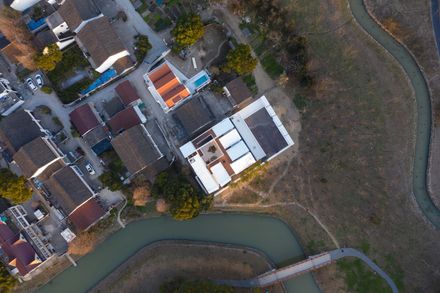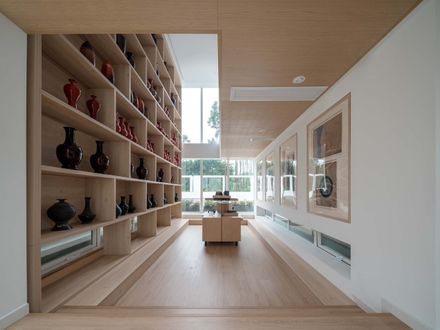Lacquer Art Experience Pavilion
ARCHITECTS
Atelier QIZAO
LOCATION
Shanghai, China
CATEGORY
Museums & Exhibit
AREA
550 m²
YEAR
2021
PHOTOGRAPHS
Runzi Zhu, Xiao Jiang, Jie Li
LEAD ARCHITECTS
Jie Li, Quan Wan
CONSTRUCTION
Shanghai Hangkuan Stadium Facilities Engineering Co. Ltd
CLIENT
Shanghai Qixi Culture Communication Co. , Ltd.
BnB is located in the Fengshou village, Pujiang Country Park, Minhang District, Shanghai. The village is located in the riverside zone between Pujiang Town and Huangpu River.
The village was spontaneously formed by the locals, showing the organic urban texture. As the area has not been centrally developed, residential housing and municipal infrastructure are decrepit.
Under the call of the National Rural Revitalization, the local village government began to renovate the original village organically.
The lacquer art experience BnB was introduced as a cultural and creative industry in order to attract tourists from the surrounding parks through the cultural and creative space experience to drive the economic development of the village.
Design Strategy, Architectural Texture. Fengshou Village is a typical traditional village in the south of the Yangtze River. The dwellings are built along both sides of the river, from the prospect of the master plan the building shows the architectural texture of free growth.
The BnB is located on the westernmost side of the Fengshou Village and the island adjacent to the country park.
The island is surrounded by water on three sides, and the south side is integrated with the country park landscape green space.
The scale of the building area is about 18*18 meters, and the shape of the building block must break up and reorganized so that it can be well integrated into the delicate architectural texture of the area.
Cluster form Impression. The practice of white walls and grey sloping roofs is basically adopted in the folk dwellings of Fengshou village.
The experience pavilion adopts 6 groups of scattered sloping roof "clusters" to echo the "architectural prototype" of local residents; The facade material continues the local practice, using white paint.
At the same time, the crack space between the clusters can allow sunlight, air and people's sight to pass through freely in order to bring a sense of breathing to the building.
On the south side of the first floor and the second floor, the cluster form is correspondingly transformed into three standard double-height exhibition space, studio and tea room; on the west side is the double-height entrance hall; and on the north side there are kitchen and experience room.
The architectural form of the sloping roof cluster is located on the three-story wooden landscape platform.
Six groups of independent sloping roofs are separated from each other, forming gaps of different sizes between the volumes.
The cracks of different sizes become the "square" and "roadway" of the roof, and the experiencers can walk among them like the experience of touring in a traditional village.
Guidance of Landscape. "Serving" and "Served" Spaces under the guidance of landscape: the east and north sides of the base are the areas of villagers' self-built houses with poor construction quality.
The south and west sides of the base are country parks with excellent view. From the perspective of master planning, the east and north sides of the building are designed as "serving Spaces" and the south and west sides are designed as "served Spaces" for public activities.
“Virtual & Real courtyard”: the scale of the site is about 20*30 meters. An outdoor "virtual courtyard" for tourists and villagers is based on the south side. The "virtual courtyard" is mainly composed of five "view frames" facing the landscape park on the south side and a piece wall on the west side, so as to keep the public open to the maximum extent while limiting the space.
Space was defined as "serving space" and "served space" in an internal "solid” courtyard, the landscape stairs were set on the east side of the garden, also a wall between the stairs and courtyard was set to maximize the isolation to the east environment, Through the opening of the cave, it is obvious to see the pitched roofs of the houses and the people walking up and down the stairs.
Due to the building's cluster form, there are a lot of “Crack Space” to connect the interior courtyard, interior space, exterior courtyard, and the country park landscape in the distance.
Promenade Architecture. The experience pavilion belongs to the public space, and it is very important for visitors and villagers to traverse the building freely. As for the aspect of the design level, the boundary of the courtyard on the south and northwest was designed as an open wall, which only serves as the boundary of the site.
Visitors and villagers can enter the site from the north and west side. The main entrance and internal lobby are located on the west side.
After entering the experience pavilion, visitors can visit the internal courtyard which connects exhibition space and artist studios, on the north side of the studio is an open staircase, visitors can wander through the stairs to cross the "crack of the wall" to get to the “Experiencing Room”, and then across the exhibition hall through a bridge, finally arrive at the east tea room on the second floor.
The first floor is also connected by an outdoor staircase to the third floor, an internal courtyard was surrounded by six groups of an individual sloped roofs. The “crack space” between the pitched roof forms "laneways" and "plazas" of different sizes, through which the view can be traverse to the south and west side of the landscape park.









































